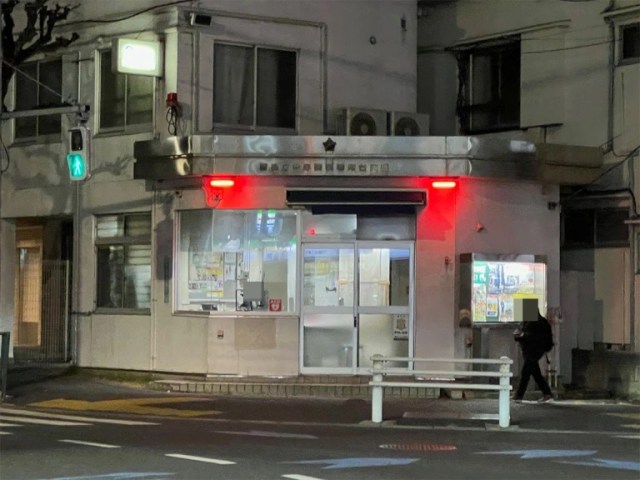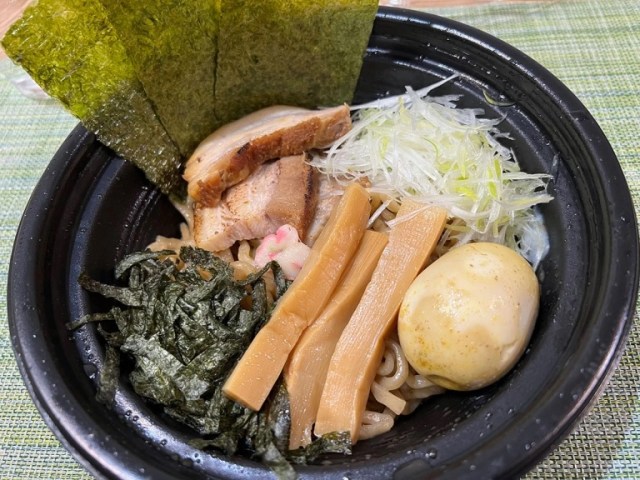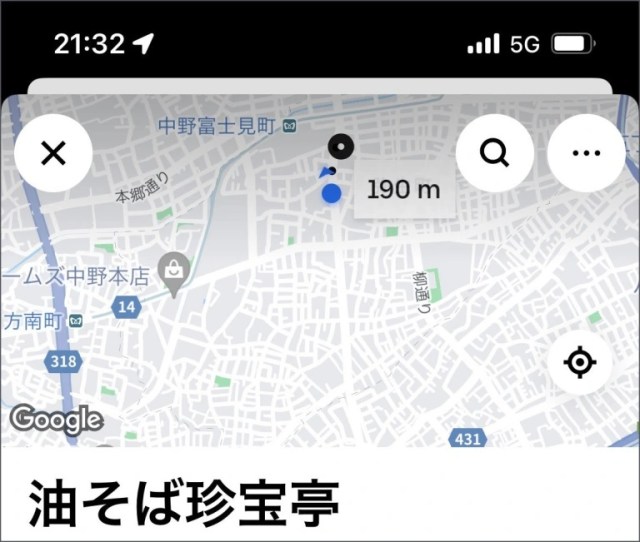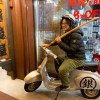
Hey, Tokyo police officer, can you give us directions to the Chinpo restaurant?
A few weeks ago, our Japanese-language reporter Yuichiro Wasai ordered some ramen through Uber Eats from a restaurant in Tokyo’s Nakano Ward. It was good, so the next time he found himself craving ramen after work, he decided to get it from that same restaurant again.
▼ The ramen Yuichiro was craving
Looking at the restaurant’s listing, though, Yuichiro noticed that in addition to delivery, they also offer takeout, i.e. you can come and pick up the food yourself. While it’d be a long walk from Yuichiro’s apartment, the restaurant was within doable biking distance, so after he got home from the office he dropped off his work bag, hopped on his bike and headed out…and almost immediately he ran into trouble.
Since Yuichiro was on his bike, he had to stop pedaling every time wanted to check the map, and he had to check the map a ton of times. That’s because when he pulled up the Uber Eats map for the restaurant’s listing, it looked like this.
That’s two street names, two station names, and not a single other landmark to navigate by over a journey of dozens of blocks, with the streets in the confusing labyrinthine array common to Japanese suburbs. So while Yuichiro knew he was in the right general area, he wound up going around and around in circles trying to find the restaurant. Among the building he kept riding past by was a police box, and sure enough, after the officer on duty saw him pass by a few times, he flagged Yuichiro down and said:
“You there, excuse me, can you stop for a moment?”
Yuichiro’s heart sank. It’s not uncommon for the police in Japan to stop people who appear to be wandering or loitering around and ask to check their ID and/or the contents of their bag. Thankfully, you’re not going to get hauled off to prison on trumped up charges, but it is a time-consuming pain, especially since the stops are sometimes seemingly performed primarily as practice for new recruits to the police force.
Still, Yuichiro figured the smoothest resolution would be to comply with the request, so he stopped his bike and the officer asked him a question.
Officer: “Where are you headed? Are you on your way home?”
Yuichiro: “No, I’m going to buy dinner.”
Officer: “So, at the supermarket?”
Yuichiro: “No, I’m going to get takeout at a restaurant called-“
And that’s where things got awkward. The name of the restaurant Yuichiro was looking for is written in kanji characters as 珍宝亭. That last kanji, 亭, pronounced “tei,” is common at the end of restaurant names in Japan. It originally refers to a fancy house, often with a garden, so putting it at the end of your establishment’s name adds a sort of rustic elegance to it. Meanwhile, the first two kanji, 珍宝, mean “rare treasure.”
Unfortunately for Yuichiro, 珍宝亭 is pronounced Chinpo-tei, and the almost identical-sounding chinpou is a Japanese slang word for “penis.” Making things worse is that 珍宝/chinpo isn’t a very common word in conversational Japanese. So as Yuichiro told the police officer he was looking for Chinpo-tei, he was fully aware that instead of the classy-sounding “Rare Treasure Dining Room,” it probably sounded like he was saying he was looking for “Chez Dick.”
And just as he’d feared, as soon as he said “I’m looking for Chinpo-tei,” the atmosphere deepened to a new level of awkwardness. Hoping to plug the uncomfortable silence with an overly thorough explanation, Yuichiro stammered “Chinpo-tei is a ramen restaurant. A while back, I ordered food from them on Uber Eats, and it was good. It looks like they allow walk-in takeout orders too, so I’m trying to find the place. It’s supposed to be around here somewhere, but it’s hard to tell from the map. Ah, you don’t happen to know where it is, do you?”
For added emphasis, Yuichiro showed the officer the map on his phone, but he still replied with:
“Yeah, looking at the map, it does look like it’s somewhere around here. But first of all, can I confirm the registration number for your bike?”
Yuichiro’s explanation of Chinpo-tei seemed to have been enough to prevent the officer getting the false impression that he was headed to some sort of culinary-themed sex club. He was stuck waiting around for a few minutes while the officer checked the bike registration records, which showed that yes, Yuichiro was indeed the owner of the bike he was on.
And yet, even after the officer thanked him for his cooperation, Yuichiro could still feel his eyes on him as he started pedaling and resumed his hunt for Chinpo-tei. So to get the officer’s gaze off his back, he took his best guess at which building in his immediate line of sight might be the one marked on the map and went inside.
It turned out to be an Indian restaurant. Looking around, Yuichiro didn’t see the kanji for Chinpo-tei written anywhere either. “Table for 1?” said an employee as they approached him.
But Yuichiro didn’t want a table, nor did he want Indian food. Maybe, just maybe, this was one of those places where the restaurant itself operates under one name, but it’s registered with a different name and menu on food delivery apps, preparing the takeout/delivery meals in the same kitchen as the other items for their in-restaurant customers. On the other hand, if the employee said that wasn’t the case, and this wasn’t Chinpo-tei, Yuichiro could just say he’d made a mistake and be on his way.
Yuichiro: “I’d like to order takeout, but is this the restaurant registered on Uber Eats as Chinpo-tei?”
Employee: “Chi-, Chi-…what?!?”
Yuichiro: “…Chinpo-tei.”
Employee: “I’m not sure. Let me go get the manager.”
“Agggggghhh!” thought Yuichiro, as his plan to create a excuse for a quick getaway backfired. But things would all work out OK if the manager said that this Indian restaurant really was also the ramen restaurant Chinpo-tei, so when the employee returned with the boss Yuichiro asked if they also operated on Uber Eats as Chinpo-tei, to which the manager, without hesitation, replied:
“Now, we don’t.”
So now Yuichiro, who’d started the evening with the simple plan to go pick up some ramen, had entered into his third awkward conversation of the night. Having now taken up two of the restaurant workers’ time, he figured he really should buy something, and so he gave up on getting ramen that night and got a to-go order of curry instead.
After some more fiddling with the Uber Eats map on a later day, Yuichiro learned that if you place your takeout order through the app itself, it then fills in more details on the map for you. Armed with that information, Yuichiro was finally able to find Chinpo-tei and get the takeout ramen he’d wanted in the first place, but on the plus side, he now knows a place to get ramen and a place to get curry in his neighborhood.
Photos ©Soranews24
● Want to hear about SoraNews24’s latest articles as soon as they’re published? Follow us on Facebook and Twitter!
[ Read in Japanese ]



 We went to a Japanese restaurant in Italy, ate green sushi, learned a lesson about taking it easy
We went to a Japanese restaurant in Italy, ate green sushi, learned a lesson about taking it easy Build-it-yourself takeout ramen kits are our new favorite noodle lunch in Tokyo
Build-it-yourself takeout ramen kits are our new favorite noodle lunch in Tokyo We visit Tokyo’s new all-plant-based cafe “Komeda Is □”
We visit Tokyo’s new all-plant-based cafe “Komeda Is □” Tokyo restaurant’s crazy huge rice omelet has 600 grams (1.3 pounds) of rice
Tokyo restaurant’s crazy huge rice omelet has 600 grams (1.3 pounds) of rice We get a ton of Starbucks goodies brought to our doorstep for a delivery cost of just 110 yen
We get a ton of Starbucks goodies brought to our doorstep for a delivery cost of just 110 yen Foreigner’s request for help in Tokyo makes us sad for the state of society
Foreigner’s request for help in Tokyo makes us sad for the state of society Japanese city loses residents’ personal data, which was on paper being transported on a windy day
Japanese city loses residents’ personal data, which was on paper being transported on a windy day Historical figures get manga makeovers from artists of Spy x Family, My Hero Academia and more
Historical figures get manga makeovers from artists of Spy x Family, My Hero Academia and more Harajuku Station’s beautiful old wooden building is set to return, with a new complex around it
Harajuku Station’s beautiful old wooden building is set to return, with a new complex around it Ghibli Park now selling “Grilled Frogs” from food cart in Valley of Witches
Ghibli Park now selling “Grilled Frogs” from food cart in Valley of Witches Celebrate another year of life by putting it in jeopardy with this birthday candle flower
Celebrate another year of life by putting it in jeopardy with this birthday candle flower Naruto art exhibition coming to Tokyo and Osaka with free, new manga for all attendees
Naruto art exhibition coming to Tokyo and Osaka with free, new manga for all attendees One of Tokyo’s most famous meeting-spot landmarks is closing for good
One of Tokyo’s most famous meeting-spot landmarks is closing for good A Gintama fan’s emotional 19-year journey to buy a proper Lake Toya bokuto wooden katana【Pics】
A Gintama fan’s emotional 19-year journey to buy a proper Lake Toya bokuto wooden katana【Pics】 Akihabara pop-up shop sells goods made by Japanese prison inmates
Akihabara pop-up shop sells goods made by Japanese prison inmates McDonald’s new Happy Meals offer up cute and practical Sanrio lifestyle goods
McDonald’s new Happy Meals offer up cute and practical Sanrio lifestyle goods Japanese ramen restaurants under pressure from new yen banknotes
Japanese ramen restaurants under pressure from new yen banknotes French Fries Bread in Tokyo’s Shibuya becomes a hit on social media
French Fries Bread in Tokyo’s Shibuya becomes a hit on social media Studio Ghibli releases new action figures featuring Nausicaä of the Valley of the Wind characters
Studio Ghibli releases new action figures featuring Nausicaä of the Valley of the Wind characters New private rooms on Tokaido Shinkansen change the way we travel from Tokyo to Kyoto
New private rooms on Tokaido Shinkansen change the way we travel from Tokyo to Kyoto Red light district sushi restaurant in Tokyo shows us just how wrong we were about it
Red light district sushi restaurant in Tokyo shows us just how wrong we were about it Tokyo Tsukiji fish market site to be redeveloped with 50,000-seat stadium, hotel, shopping center
Tokyo Tsukiji fish market site to be redeveloped with 50,000-seat stadium, hotel, shopping center All-you-can-drink Starbucks and amazing views part of Tokyo’s new 170 meter-high sky lounge
All-you-can-drink Starbucks and amazing views part of Tokyo’s new 170 meter-high sky lounge Beautiful Ghibli sealing wax kits let you create accessories and elegant letter decorations【Pics】
Beautiful Ghibli sealing wax kits let you create accessories and elegant letter decorations【Pics】 Studio Ghibli releases Kiki’s Delivery Service chocolate cake pouches in Japan
Studio Ghibli releases Kiki’s Delivery Service chocolate cake pouches in Japan New definition of “Japanese whiskey” goes into effect to prevent fakes from fooling overseas buyers
New definition of “Japanese whiskey” goes into effect to prevent fakes from fooling overseas buyers Our Japanese reporter visits Costco in the U.S., finds super American and very Japanese things
Our Japanese reporter visits Costco in the U.S., finds super American and very Japanese things Studio Ghibli unveils Mother’s Day gift set that captures the love in My Neighbour Totoro
Studio Ghibli unveils Mother’s Day gift set that captures the love in My Neighbour Totoro More foreign tourists than ever before in history visited Japan last month
More foreign tourists than ever before in history visited Japan last month New Pokémon cakes let you eat your way through Pikachu and all the Eevee evolutions
New Pokémon cakes let you eat your way through Pikachu and all the Eevee evolutions Sales of Japan’s most convenient train ticket/shopping payment cards suspended indefinitely
Sales of Japan’s most convenient train ticket/shopping payment cards suspended indefinitely Sold-out Studio Ghibli desktop humidifiers are back so Totoro can help you through the dry season
Sold-out Studio Ghibli desktop humidifiers are back so Totoro can help you through the dry season Japanese government to make first change to romanization spelling rules since the 1950s
Japanese government to make first change to romanization spelling rules since the 1950s Ghibli founders Toshio Suzuki and Hayao Miyazaki contribute to Japanese whisky Totoro label design
Ghibli founders Toshio Suzuki and Hayao Miyazaki contribute to Japanese whisky Totoro label design Doraemon found buried at sea as scene from 1993 anime becomes real life【Photos】
Doraemon found buried at sea as scene from 1993 anime becomes real life【Photos】 Tokyo’s most famous Starbucks is closed
Tokyo’s most famous Starbucks is closed One Piece characters’ nationalities revealed, but fans have mixed opinions
One Piece characters’ nationalities revealed, but fans have mixed opinions We asked a Uniqlo employee what four things we should buy and their suggestions didn’t disappoint
We asked a Uniqlo employee what four things we should buy and their suggestions didn’t disappoint Princesses, fruits, and blacksmiths: Study reveals the 30 most unusual family names in Japan
Princesses, fruits, and blacksmiths: Study reveals the 30 most unusual family names in Japan A daddy/daughter test of the free baby meals at Japan’s biggest soup restaurant chain【Taste test】
A daddy/daughter test of the free baby meals at Japan’s biggest soup restaurant chain【Taste test】 We ask for an “omakase” selection from Starbucks’ Tokyo bakery Princi, with surprising results
We ask for an “omakase” selection from Starbucks’ Tokyo bakery Princi, with surprising results We’re utterly stumped by this kids’ Spot the Difference Puzzle from a Japanese family restaurant
We’re utterly stumped by this kids’ Spot the Difference Puzzle from a Japanese family restaurant We tried Mama’s Poop served fresh from a Tokyo eatery
We tried Mama’s Poop served fresh from a Tokyo eatery Our reporter orders food from Uber Eats, falls in love, learns that fate works in mysterious ways
Our reporter orders food from Uber Eats, falls in love, learns that fate works in mysterious ways We miss out on cheap all-you-can-eat takoyaki, but stuff ourselves with octopus balls anyway
We miss out on cheap all-you-can-eat takoyaki, but stuff ourselves with octopus balls anyway Try our crappy lifehack for “better BMs”
Try our crappy lifehack for “better BMs” We lost the Starbucks lucky bag lotto, so we went on a luxury Starbucks shopping spree instead
We lost the Starbucks lucky bag lotto, so we went on a luxury Starbucks shopping spree instead Is this frozen tonkatsu sandwich vending machine really worth 700 yen?【Taste test】
Is this frozen tonkatsu sandwich vending machine really worth 700 yen?【Taste test】 Tokyo Sushi for US 8 cents a piece (as long as you also want a beer) makes us believe in miracles
Tokyo Sushi for US 8 cents a piece (as long as you also want a beer) makes us believe in miracles We spend Culture Day in prison, food was arguably better than Yoshinoya
We spend Culture Day in prison, food was arguably better than Yoshinoya A story of how Starbucks Reserve Roastery products always make us forget about money management
A story of how Starbucks Reserve Roastery products always make us forget about money management Amazon Japan are selling Uber Eats backpacks and they’re surprisingly useful
Amazon Japan are selling Uber Eats backpacks and they’re surprisingly useful Our reporter investigates the strangely named “shaved ice donburi” at a Tokyo cafe
Our reporter investigates the strangely named “shaved ice donburi” at a Tokyo cafe How much will three packs of Pokémon cards bought overseas fetch in Japan?
How much will three packs of Pokémon cards bought overseas fetch in Japan?
Leave a Reply